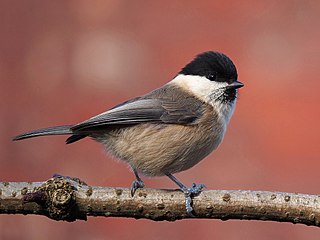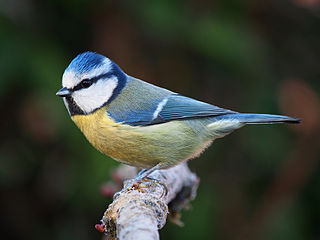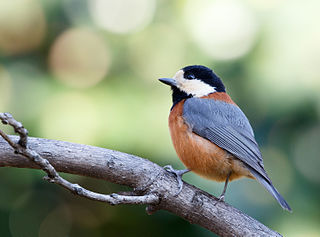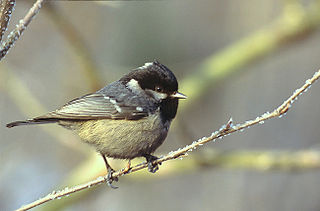
The penduline tits constitute the family, Remizidae, of small passerine birds, related to the true tits. All but the verdin make elaborate bag nests hanging from trees, usually over water.

The tits, chickadees, and titmice constitute the Paridae, a large family of small passerine birds which occur mainly in the Northern Hemisphere and Africa. Most were formerly classified in the genus Parus.

The marsh tit is a passerine bird in the tit family Paridae and genus Poecile, closely related to the willow, Père David's and Songar tits. It is a small bird, around 12 cm (4.7 in) long and weighing 12 g (0.42 oz), with a black crown and nape, pale cheeks, brown back and greyish-brown wings and tail. Between 8 and 11 subspecies are recognised. Its close resemblance to the willow tit can cause identification problems, especially in the United Kingdom where the local subspecies of the two are very similar: they were not recognised as separate species until 1897.

The willow tit is a passerine bird in the tit family, Paridae. It is a widespread and common resident breeder throughout temperate and subarctic Europe and across the Palearctic. The plumage is grey-brown and off-white with a black cap and bib. It is more of a conifer specialist than the closely related marsh tit, which explains it breeding much further north. It is resident, and most birds do not migrate.

The Eurasian blue tit is a small passerine bird in the tit family, Paridae. It is easily recognisable by its blue and yellow plumage and small size.

The European crested tit, or simply crested tit, is a passerine bird in the tit family Paridae. It is a widespread and common resident breeder in coniferous forests throughout central and northern Europe and in deciduous woodland in France and the Iberian peninsula. In Great Britain, it is chiefly restricted to the ancient pinewoods of Inverness and Strathspey in Scotland, and seldom strays far from its haunts. A few vagrant crested tits have been seen in England. It is resident, and most individuals do not migrate.

The grey-headed chickadee or Siberian tit is a passerine bird in the tit family Paridae. It is a widespread resident breeder throughout subarctic Scandinavia and the northern Palearctic, and also into North America in Alaska and the far northwest of Canada. It is a conifer specialist. It is resident, and most birds do not migrate. Curiously, the bird has no grey on its head, which is black, white, and brown.

The Himalayan black-lored tit, also known as simply black-lored tit, is a passerine bird in the tit family Paridae. The yellow-cheeked tit is probably its closest relative, and it may also be related to the yellow tit. These three tits almost certainly form a distinct lineage, as indicated by morphology, and mtDNA cytochrome b sequence analysis.

The azure tit is a passerine bird in the tit family Paridae. It is a widespread and common resident breeder throughout Russia and Central Asia and northwest China, Manchuria and Pakistan.

The Mexican chickadee is a small songbird, a passerine bird in the tit family Paridae. It is still often placed in the genus Parus with most other tits, but mtDNA cytochrome b sequence data and morphology suggest that separating Poecile more adequately expresses these birds' relationships. The American Ornithologists' Union had been treating Poecile as distinct genus for some time already.

The rufous-naped tit, also known as the black-breasted tit or dark-grey tit, is an Asian songbird species in the tit and chickadee family (Paridae). It was sometimes considered conspecific with the rufous-vented tit, and was formerly placed in the genus Parus.

The white-winged black tit is a passerine bird in the tit family Paridae. It is also known as the white-winged tit, dark-eyed black tit or northern black tit. The species was first described by Eduard Rüppell in 1840.

Clamator is a genus of large brood-parasitic cuckoos with crests and graduated tails.

The varied tit is a perching bird from the tit family, Paridae. It occurs in the eastern Palearctic in Japan, Korea, and locally in northeastern China and extreme southeastern Russia.

Parus is a genus of Old World birds in the tit family. It was formerly a large genus containing most of the 50 odd species in the family Paridae. The genus was split into several resurrected genera following the publication of a detailed molecular phylogenetic analysis in 2013. The genus name, Parus, is the Latin for "tit".

Poecile is a genus of birds in the tit family Paridae. It contains 15 species, which are scattered across North America, Europe and Asia; the North American species are the chickadees. In the past, most authorities retained Poecile as a subgenus within the genus Parus, but treatment as a distinct genus, initiated by the American Ornithologists Union, is now widely accepted. This is supported by mtDNA cyrochrome b sequence analysis.

Periparus is a genus of birds in the tit family. The birds in the genus were formerly included in Parus but were moved to Periparus when Parus was split into several resurrected genera following the publication of a detailed molecular phylogenetic analysis in 2005. The name Periparus had been introduced for a subgenus of Parus that included the coal tit by the Belgium naturalist Edmond de Sélys Longchamps in 1884. The genus name, is Ancient Greek peri plus the pre-existing genus Parus.

Pardaliparus is a genus of birds in the tit family. The members of the genus were formerly included in Parus but were moved to Pardaliparus when Parus was split into several resurrected genera following the publication of a detailed molecular phylogenetic analysis in 2013.

The Indian black-lored tit, Indian tit, or Indian yellow tit is a passerine bird in the tit family Paridae. The yellow-cheeked tit is probably its closest relative, and both may be related to the yellow tit. These three tits almost certainly form a distinct lineage as evidenced by morphology, and mtDNA cytochrome b sequence analysis. The subgenus name Macholophus may apply for them.

Machlolophus is a genus of birds in the tit family. The species were formerly placed with many others in the genus Parus but were moved to Machlolophus based on a molecular phylogenetic analysis published in 2013 that showed that the members formed a distinct clade.























